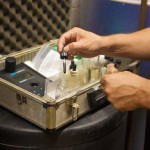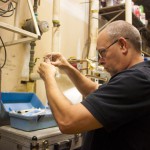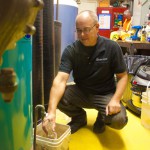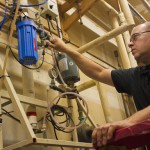Process for making water acceptable for the intended use, such as drinking (potable) water or industrial applications. Purification is the most common objective, commonly involving filtration, softening, and disinfection. May also involve pH adjustment and removal of taste and odours.
A measure of how acidic or basic a substance is, on a scale from 1 to 14. A value of 7 indicates a neutral pH. pH`s below 7 indicate acid. pH`s above 7 indicate the opposite of acid, base.
Water that is free from disease containing organisms »»(pathogens) and free from any contaminants that are detrimental to health.
A process to remove iron from water. The treatment method varies depending on whether the water contains bacterial iron (slim), ferric iron (non-soluble), or ferrous iron (soluble). Bacterial iron treatment involves chlorination and filtration. Removal of ferric iron involves filtration. Removal of ferrous iron involves ion exchange (softening). Some iron treatment involves the oxidation of ferrous iron to ferric ion before removal. The introduction of ferric ion into a water softener can lead to fouling of the water softener.
The concentrations of calcium, magnesium, sulfate, chloride ions expressed in term of calcium carbonate. Scale formed by hardness increases soap demand, causes staining on cloths and fixtures, and leaves a deposit on the skin after bathing. Water with a hardness of more than 120 to 150 mg per litre of calcium carbonate equivalent is considered to be hard. Scale formed by hardness in water is also detrimental to boilers, cooling towers, water kettles and water heaters. Scale buildup restricts water flow, heat exchange and produces cloudy appearance in swimming pools. Water hardness is reduced by the use of a water softener which exchanges sodium ions for the hardness ions. Softened water therefore contain higher levels of sodium unless potassium chloride is substituted for the sodium chloride (salt) normally used to regenerate the softener.
Water odour can come from various sources. The most common being a `rotten egg` smell caused by hydrogen sulfate gas (H2S). Other ``fishy`` , ``earthy``, and ```musty`` or ``metallic odours can be caused by a variety of contaminants, some of which cannot be easily removed. The most common method of removing odours and tastes from drinking water is use of activated carbon filtration. Other methods involve the removal of the cause of the odour such as the removal of sulfate and or iron and or manganese by a water softener or other methods such as oxidation by ozone or chlorine.
Salt contamination in drinking water can come from naturally occurring salt deposits, runoff containing road salt, salt water intrusion from water bodies, or pollution from septic systems. Excessive salt intake can have a detrimental effect on health including high blood pressure. Salt in drinking water can be reduced by replacing the well, connecting to public water supplies or treating the water to remove the salt using reverse-osmosis.
Perform routine maintenance or repair to do the work that is needed to keep a machine in good working order. To provide replenishment of supplies, verification of functionality, calibration, lubrication and cleaning as required.
To fix or restore to proper operation by cleaning, lubricating, replacing or rebuilding a part that is malfunctioning or broken.
To place or attach in position or connect for service and prepare for use. To prepare the site and furnish necessary connections required for operation of the equipment. To verify proper operation and that the equipment requirements are met.
Water Softeners reduce soap consumption by moving the hardness from the water. Water hardness reduces the cleaning strength of detergents. Softened water can reduce soap requirements by up to 70%, make cloths brighter and last longer, reduce spots and streaks on dishes, as well as make washing floors easier by eliminating soap scum.
Water purification using semi-permeable membrane , resulting in pure drinking water that is free from contaminants such as salt, fluoride, fine particles down to the molecular level , and reducing arsenic, cysts including cryptosporidium, giardia (beaver fever), copper, lead, and reducing turbidity. Normally made up of a system which includes a 5 -micron pre-filter, RO (Reverse Osmosis) Membrane, and post carbon filter to reduce taste and odour.
A device that reduces water hardness using ion exchange resin to replace calcium, magnesium, and other hardness ions with sodium. Normally regenerated with salt. Produces water with greater sudsing power (soap saver) and reduces staining of porcelain fixtures, and enhances cleaning ability.
A method of water purification using ultra violet radiation, normally produced by a mercury vapour lamp, to kill micro organisms and pathogens without the use of chemicals. Does not affect the taste, odour or colour of the water . Effective against crypto cryptosporidium, giardia (beaver fever). Water must be pre-filtered to remove particles larger than 5 micron. The UV transmittance of the water (loosely inversely related to the turbidity) must be high enough order for UV disinfection to be effective.
A metallic contaminant normally found with iron in water , resulting in black staining of porcelain fixtures and producing a sharp metallic taste. Black staining in the back of the toilet usually indicates manganese. Can be removed with a water softener. May require changing the sacrificial anode in the hot water tank from manganese to aluminium. Black slimy growths in the back of the toilet indicate manganese-loving bacteria.
A metallic contaminant normally found with manganese in water , resulting in brown staining of porcelain fixtures and producing a metallic taste. Brown staining in the back of the toilet usually indicates manganese. Can be removed with a water softener. Brown slimy growths in the back of the toilet indicate iron-loving bacteria.
A natural organic contaminant in water resulting in tea-like staining of porcelain fixtures and clothing and bitter taste. Occurring primarily in surface water as a result of humic acids leaching from organic matter such as leaves. Stains produced by tanins can be difficult to remove and require a special cleaner. Tanins can be removed with a water softener but require a special “anion” resins.
A polysaccharide derived from plant cell walls. Often occurring with tanins results in tea-like staining of porcelain fixtures and a bitter taste in drinking water. Tanins can be removed with a water softener but require a special “anion” resins.
A measure of the inorganic and organic substances dissolved in water which will pass through a 2 micron filter, most often potassium, sodium and chlorides. The TDS for drinking water should not exceed 200ppm. High TDS results in salty, bitter, or metallic taste. TDS is reduced by reverse osmosis a low TDS is desirable for car washing, window cleaning, aquariums and brewing coffee.




